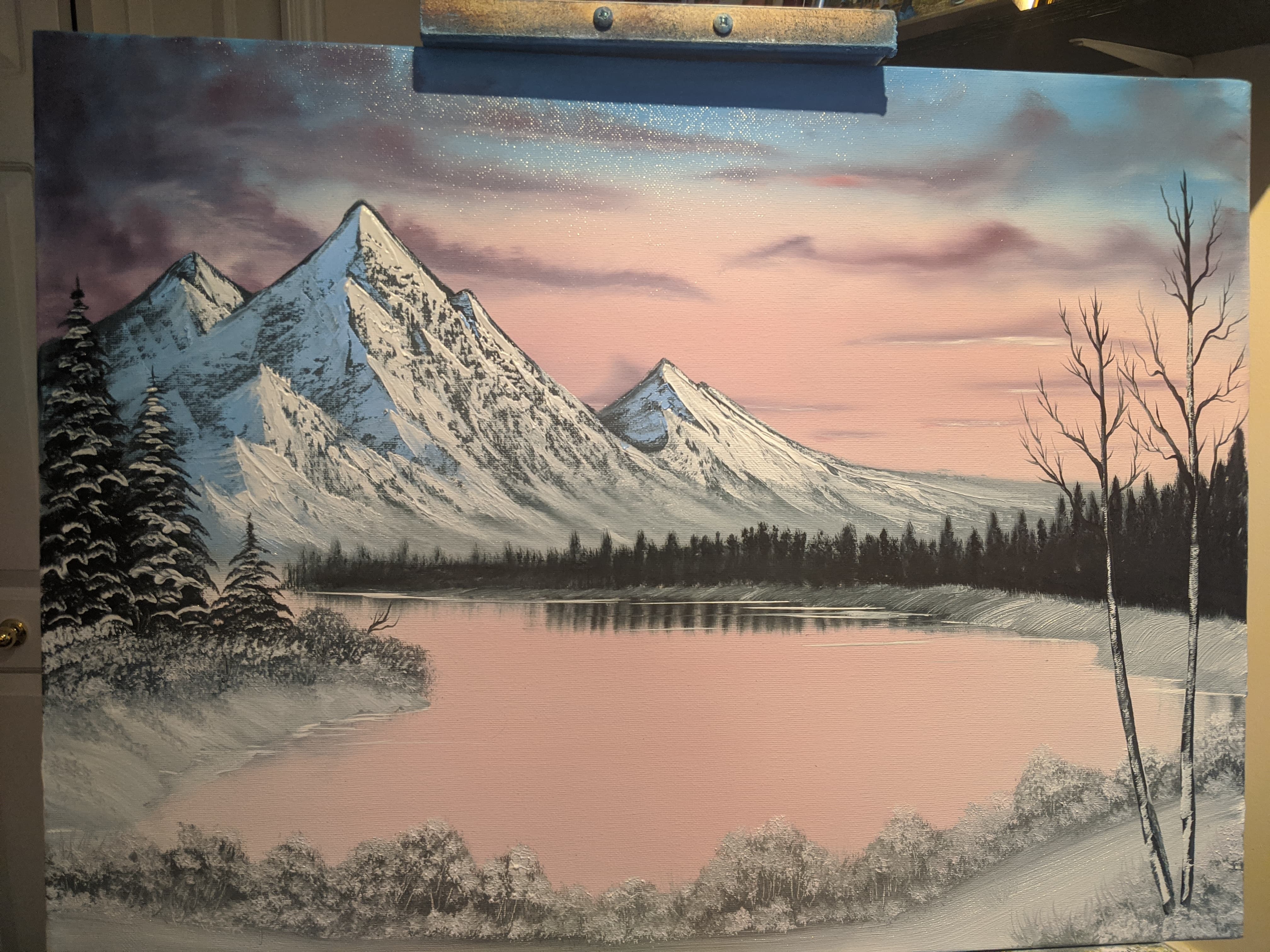Pictured below - My second attempt at Winter Frost

The purpose of this brief article is to share with everyone in our painting community the lessons I've learned on how to make snow break properly on a mountain. It finally hit me while painting this one yesterday, all variables coalescing nicely. I will list the process in point form, for simplicity's sake:
Canvas: Doesn't really matter. Bob recommends double primed. I buy value canvases that were supposedly single primed and I prime it myself with white gesso once. You want it smooth but with a slight bit of tooth to it.
Liquid white: Add a thin, even coat. Don't be too stingy. Start in all 4 corners and work across. Scrub it in with the brush. Use long horizontal and vertical strokes after to ensure an even coat. Use the finger print trick to test - put your index finger on all 4 corners (wiping off your finger in between). You should be able to see a nice white "finger print" on your finger. If it's too light, add a bit more liquid white. If it's way too dense, consider wiping down the canvas lightly and evenly with a paper towel or soft rag.
Sky and clouds: Create your sky the way you normally would - tap your two inch brush into a bit of paint, blending the color right on the canvas due to the liquid white.
Mountain base color: This is the first important point. Create a nice, dark color on your palette. I like using black, dark blue, a bit of crimson, creating a very dark blue or purplish base color. Use the knife to create the edges of the mountain and really work in that color with the knife, effectively 'staining' the canvas, blocking in that mountain shape. Now, here is where the first piece of learning happened for me recently: Bob recommends to scratch out all excess color and pull down with the two inch brush. That's what I always did. Yesterday, I realized that isn't enough. Case in point - if you look at my painting above, check the highlights on the right smaller mountain to the highlights on the left mountain. You can distinctly tell the highlights to the right are 'caked' and the snow does not break. This is because I was going about my business as usual with the right peak.
Important point # 1: After scratching all that base color and liquid white off with your knife, and scratching some more, and then scratching even more just for good measure, use a paper towel and wipe all of that paint off! Don't be shy. Wipe all paint off until your canvas is practically dry where the mountain is, just leaving behind a mountain shaped stain. Wipe it down to death.
Important point # 2: Use a titanium white that is super thick and dry. The Bob Ross brand titanium white I have is ironically not thick enough, really oily. I recently got a tube of cheap Van Gogh brand titanium white and it's really thick. What I learned is that if I spread out a generous glob of white onto a piece of cardboard about 20 minutes before I use it, the excess oil gets soaked up into the cardboard. I then spread it around the cardboard with the knife, then take it all and add it back to my palette. What you're left with is an excessively dry and firm paint that is almost difficult to spread out onto the palette. Really work it to death. You might want to put your palette down onto a table and really give yourself enough room to spread out that titanium white with the knife. Then, you cut a small roll just like Bob does.
Important point # 3: Grab the knife lightly and just let it graze down the mountain, following angles. After following the process noted above, I was surprised at how easy it was to get the paint to break. It just happens because the paint is so thick. It can actually get difficult to get the paint to stick at times! This is the complete opposite to what I had experienced in the past.
I think that's it. I tend to ramble, so I added these important points above. It just worked so well and was so simple. I'll add a brief summary here for those that may not want to read all of my ramblings.
Cliff notes:
When you create the mountain shape with dark color, scratch out all that excess paint and liquid white with the knife. Then, use a paper towel to really scrub out ALL the paint, leaving behind just a stain. Wipe it down until it's almost dry - the dryer the better!
When working with titanium white, use a stiff, firm brand of paint like Van Gogh. Spread it on cardboard and let it soak up the excess oil for 20 minutes or so before using it. Scoop it up and back on your palette. Put the palette down on a table, grab your knife, and really work it to death spreading it out. Now I understand what Bob means when he says 'get tough with it.' It'll be super dry and firm.
Load the knife with a small roll, gently add to the mountain. It'll break on its own. Doing it in short, fast strokes helps a lot. After you've added your highlights, you can even got over a few more times to add more breaking snow. I did this in the picture above.
That's it. This is a complete game changer for me and I really wanted to share this with everyone as soon as I could. Hope this helps!
Great article! Especially the tip with removing any paint from the mountain shape seems really good